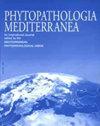Infection of papaya (Carica papaya) by four powdery mildew fungi
IF 1.9
3区 农林科学
Q2 AGRONOMY
引用次数: 2
Abstract
Papaya (Carica papaya L.) is an important fruit crop in many tropical and subtropical countries. Powdery mildew commonly affects this host, causing premature leaf loss, reduced yields and poor fruit quality. At least fifteen different fungi have been identified as the causal agents of papaya powdery mildew. Powdery mildew symptoms were detected on potted papaya plants growing in two locations in Hungary. This study aimed to identify the causal agents. Morphology of powdery mildew samples was examined, and sequences of two loci were used for molecular taxonomic identifications. Only anamophs were detected in all samples, and four morphological types were distinguished. Most samples had Pseudoidium anamorphs, while some were of the Fibroidium anamorph. Based on morphology and molecular taxonomy, the Fibroidium anamorph was identified as Podosphaera xanthii. The Pseudoidium anamorphs corresponded to three different Erysiphe species: E. cruciferarum, E. necator and an unidentified Erysiphe sp., for which molecular phylogenetic analyses showed it belonged to an unresolved species complex of E. malvae, E. heraclei and E. betae. Infectivity of P. xanthii and E. necator on papaya was verified with cross inoculations. A review of previous records of powdery mildew fungi infecting papaya is also provided. Podosphaera xanthii was known to infect, and E. cruciferarum was suspected to infect Carica papaya, while E. necator was recorded on this host only once previously. No powdery mildew fungus belonging to the E. malvae/E. heraclei/E. betae species complex is known to infect papaya or any other plants in the Caricaceae, so the unidentified Erysiphe sp. is a new record on papaya and the Caricaceae. This study indicates host range expansion of this powdery mildew fungus onto papaya.四种白粉菌对番木瓜的感染
番木瓜(Carica木瓜L.)是许多热带和亚热带国家的重要水果作物。白粉菌通常影响该宿主,导致叶片过早脱落、产量下降和果实质量下降。至少有15种不同的真菌已被鉴定为木瓜白粉菌的致病因素。在匈牙利的两个地方,人们在种植木瓜的盆栽植物上发现了霉菌症状。本研究旨在确定原因。对白粉菌样品进行了形态学检查,并利用两个基因座的序列进行了分子分类学鉴定。在所有样本中只检测到anamophs,并区分了四种形态类型。大多数样品具有假球藻变体,而一些样品具有纤球藻变体。根据形态学和分子分类学,将无变型纤球藻鉴定为黄球藻(Podosphaera xanthii)。Pseudodium anamorphs对应于三个不同的丹毒物种:十字花丹毒、necator丹毒和一个未鉴定的丹毒属。分子系统发育分析表明,它属于一个未解决的马尔瓦丹毒、赫拉克勒丹毒和贝塔丹毒的物种复合体。用交叉接种法验证了黄曲霉和necator对番木瓜的感染性。还提供了对以前感染番木瓜的白粉菌的记录的回顾。已知黄球藻会感染番木瓜,十字花菜大肠杆菌被怀疑会感染番番木瓜,而necator大肠杆菌以前只在该宿主上记录过一次。没有属于E.malvae/E。heraclei/E。已知甜菜碱物种复合物会感染番木瓜或任何其他加勒比科植物,因此未鉴定的丹毒属是番木瓜和加勒比科的一个新记录。本研究表明,该白粉菌在番木瓜上的寄主范围扩大。
本文章由计算机程序翻译,如有差异,请以英文原文为准。
求助全文
约1分钟内获得全文
求助全文
来源期刊

Phytopathologia Mediterranea
生物-植物科学
CiteScore
4.40
自引率
8.30%
发文量
28
审稿时长
6-12 weeks
期刊介绍:
Phytopathologia Mediterranea is an international journal edited by the Mediterranean Phytopathological Union. The journal’s mission is the promotion of plant health for Mediterranean crops, climate and regions, safe food production, and the transfer of new knowledge on plant diseases and their sustainable management.
The journal deals with all areas of plant pathology, including etiology, epidemiology, disease control, biochemical and physiological aspects, and utilization of molecular technologies. All types of plant pathogens are covered, including fungi, oomycetes, nematodes, protozoa, bacteria, phytoplasmas, viruses, and viroids. The journal also gives a special attention to research on mycotoxins, biological and integrated management of plant diseases, and the use of natural substances in disease and weed control. The journal focuses on pathology of Mediterranean crops grown throughout the world.
The Editorial Board of Phytopathologia Mediterranea has recently been reorganised, under two Editors-in-Chief and with an increased number of editors.
 求助内容:
求助内容: 应助结果提醒方式:
应助结果提醒方式:


